This text has been merged within another entry (here)
Category: Demography
Excerpted from the 11th article of William Pierce’s “Who We Are: a Series of Articles on the History of the White Race”:
The foregoing remarks are especially well illustrated by the fate of a related group of Indo-European tribes whose members called themselves Aryans. Although the name “Aryan” is sometimes used to designate any person of Indo-European ancestry, it applies especially to the tribes which, beginning probably in the third millennium B.C., migrated eastward and southeastward from the ancient Nordic homeland, some going down through Turkistan and into Iran from the northeast—and some into the more easterly foothills of the Hindu Kush, in what is now Afghanistan.
The high Iranian plateau, much of it covered with grass, provided an ideal territory for the horsemen from the northern steppes. They multiplied and prospered, raiding their non-Indo-European neighbors in the Zagros Mountains or on the edge of the Sumerian plain from time to time, collecting slaves and booty. They maintained their racial purity scrupulously enough, however, so that, as late as the middle of the first millennium B.C., King Darius the Great could still proudly and truthfully boast: “I am an Aryan, the son of an Aryan.”
But Semites and other aliens became more numerous in Iran as the might and wealth of the Aryan Persians grew. In the reign of Darius’ son Xerxes, as we know from the Old Testament’s Book of Esther, Jews were already quite influential there. Today, 2,500 yeas later, the Iranians are no more Aryan than their Semitic neighbors, so thoroughly have the genes of the various races in that part of the world been mixed.
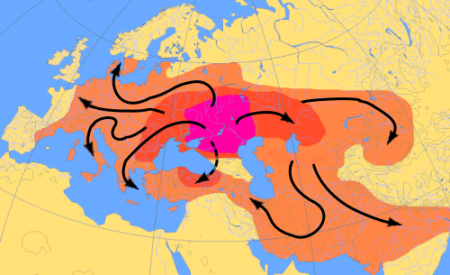 (Here Pierce writes several paragraphs about the conquest of India, then he adds:)
(Here Pierce writes several paragraphs about the conquest of India, then he adds:)
Crop of Half-Breeds
The first step may be a simple matter of military indiscipline: the rape of a few hundred dasyu women in a rebellious district after a revolt is put down by Aryan warriors. Twenty years later there will be a crop of half-breeds in that district, and some of the half- breed females will be much lighter and comelier than the average dasyu.
These light ones will be especially likely to be targeted for rape the next time there is a rebellion—or the next time a gang of drunken Aryans goes out on the town. And so, 20 years later, there will be some quarter-breeds around—and some of these may be light enough to be chosen as concubines by the local Aryan landlord.
Beware the almost-Whites!
And so it goes, century after century, with the simple Black-White picture gradually giving way to one in which there is a continuous range of mongrels between the two racial extremes. Near the White end of the spectrum there will be some who, although carrying some dasyu genes, will be almost indistinguishable from the true Aryans. Drawing the line between what is Aryan and what is not becomes more and more difficult. And as the racial picture becomes more blurred, the will to preserve the race is sapped. Many of the almost-Aryans will be bright and energetic citizens; style will be mistaken for substance; the keen edge of the Aryan race-soul will be blunted by imperceptible degrees.
(Nuristani kids from Afghanistan)
By the time the damage has become quite noticeable, racial decadence has become irreversible. The subtle but essential qualities of psyche and intellect in the Aryans which led to conquest and to the building of Aryan civilization are diluted to ineffectiveness in their almost-Aryan descendants 15 or 20 centuries later, even though fair hair and blue eyes may still be abundant.
That is what happened to Aryan Persia and Aryan India. And it is also what is happening to Aryan America and Aryan Europe today.
Excerpted from the 10th article of William Pierce’s “Who We Are: a Series of Articles on the History of the White Race”:
And what a contrast between the Hellenes and their achievements, on the one hand, and what existed before—and has existed since—in Greece! That is not to say that every Greek of today is unimaginative or insensitive or ugly, but it is clear that something essential has been lost between the time of Aristotle and the time of his late namesake, Mr. Onassis. And the loss was at least as great between the time of Achilles and Aristotle, although the culture-lag phenomenon tends to mask this earlier decline in racial quality.
The Hellenic genes are still there, the genes of the race which gloried in single combat between equals facing one another on the field of battle and pitting skill, courage, and strength in a contest to the death, but they are now submerged in the genes of a race which always preferred to sling its stones from afar, to lie in stealthy ambush, to give a surprise knife-thrust from the rear. The race-soul which first envisioned the symmetry of the Doric temple and pondered the mysteries of existence as none before it has become inextricably mingled with one concerned, first and last, with personal advantage and disadvantage, profit and loss.
Extermination or Expulsion
This catastrophic mixing of bloods has occurred over and over again in the history and prehistory of our race, and each time it has been lethal. The knowledge of this has been with us a long time, but it has always failed us in the end. The Hellenes of Sparta and Athens both strove to keep their blood pure, but both ultimately perished. The only way they could have survived would have been to eliminate the entire indigenous population, either through expulsion or extermination, from the areas of the Mediterranean world in which they settled.
The Hellenes always possessed a certain feeling of racial unity, distinguishing themselves sharply from all those not of their blood, but this racial feeling was, unfortunately, usually overshadowed by intrarracial conflicts. The rivalries between Hellenic city-states were so fierce and so pervasive, that the Mediterranean natives were more often looked upon as a resource to be used against other Hellenes than as a biological menace to be eliminated.
Economics over Race
The ultimate downfall of the Nordic conquerors in Asia, just as in the Mediterranean world, can be traced to an economic consideration and to an error in human judgment. The economic consideration was that a conquered population, just like the land itself or the gold and other booty seized by the conquerors, had real value. Whether the people were enslaved or merely taxed as subjects, they were an economic resource which could be exploited by the conquerors. To drive them off the land or wipe them out completely would, from a strictly economic viewpoint, be akin to dumping captured gold into the ocean.
Such an action could be justified to a conquering tribe of Indo-Europeans only if they were willing to subordinate all economic considerations to the goal of maintaining their racial integrity into the indefinite future—and if they also had a sufficiently deep understanding of history to foresee the inevitability of racial mixing wherever two races are in close proximity. Unfortunately, even where the will for racial survival was very strong, the foresight was insufficient. Measures which were quite adequate to prevent racemixing for a few generations, or even for a few centuries, broke down over the course of a thousand years or more.
Excerpted from the tenth article of William Pierce’s “Who We Are: a Series of Articles on the History of the White Race”:
At the beginning of the fifth century B.C. the Spartiates were able to field an army of 8,000 men against the Persians, but after the costly Spartan victory over Athens and her allies in the Peloponnesian War (431 -404 B.C.) Spartan numbers declined rapidly. When the Spartiates marched against Thebes in 371 B.C., there were too few of them to prevail. After their decisive defeat by the Thebans at Leuctra, the Spartan army numbered only 2,000 warriors. A century and a half later there were only 700 of them, and they passed from the pages of history.
The Spartiates never succumbed to racemixing, but they did succumb to their own lifestyle. They would have been well advised to eliminate the Helots of the Peloponnesus and the Mediterranean population of Crete altogether and to establish a purely Dorian peasant class in those areas. Then they may well have been able to practice a successful eugenics program, maintain their moral health, and have a stable population too. But, of course, they did not have the advantage which hindsight gives us.
The other Hellenic tribes did succumb to racemixing. Their populations did not suffer the decline in numbers which the Spartiates did, but they suffered a decline in racial quality which resulted in their extermination, perhaps more slowly but just as surely—and less cleanly.
Predominantly Nordic
Still, the earliest Athenians were, like the other Hellenes, predominantly Nordic in blood and culture. Their social structure was aristocratic, and they were ruled originally by hereditary kings, just as in the case of the Spartiates.
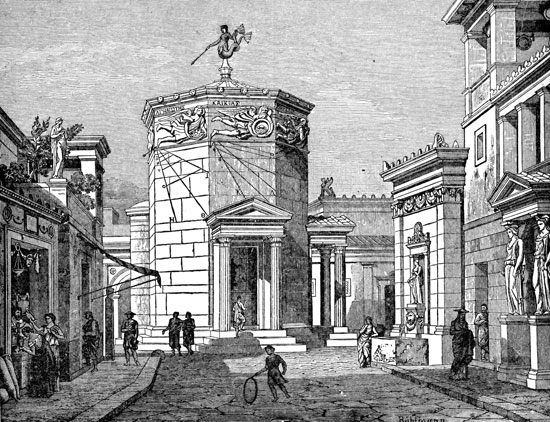 Although Athenian tradition credits the legendary King Theseus with the political unification of the various semi-independent townships of Attica into a single “greater Athens” during the Heroic Age, it is certain that this unification actually did not take place until long after the Dorian invasion. In any event, the monarchy did not last long in unified Attica, and at the dawn of history the Athenians were ruled by a coalition of noble families, the Eupatrids (“those who are well sired”).
Although Athenian tradition credits the legendary King Theseus with the political unification of the various semi-independent townships of Attica into a single “greater Athens” during the Heroic Age, it is certain that this unification actually did not take place until long after the Dorian invasion. In any event, the monarchy did not last long in unified Attica, and at the dawn of history the Athenians were ruled by a coalition of noble families, the Eupatrids (“those who are well sired”).
Race-Based Citizenry
Even after Solon, however, democracy did not devour the Athenians all at once. Solon and the tyrants who gained power shortly after his administration, the Peisistratids, governed an Athens in which citizenship was still a racial matter, being based on membership in one of the kinship groups, or clans, which made up the Hellenic tribes of Attica.
In 509 B.C., 85 years after the beginning of Solon’s administration, another “reformer,” Cleisthenes, took office, and he undertook a program of gerrymandering which laid the basis for changing citizenship from a racial to a geographic affair. From this point it was downhill all the way for Athens, racially speaking.
Half a century later the last remnants of power were transferred from the Areopagus to a popular council. All the abuses of mass party politics with which Americans are all too familiar were thenceforth the lot of the Athenians.
Law of Pericles
As the prosperity of Athens grew, more and more foreigners crowded into Attica, with intermarriage inevitably occurring. A temporary halt to the pollution of the Athenian citizenry by the offspring of aliens came in 451 B.C., when the great Pericles pushed through a law restricting citizenship to those born of an Athenian father and an Athenian mother. Only four decades later, however, in order to make up the enormous losses suffered in the Peloponnesian War, Athens bestowed citizenship on tens of thousands of foreigners.
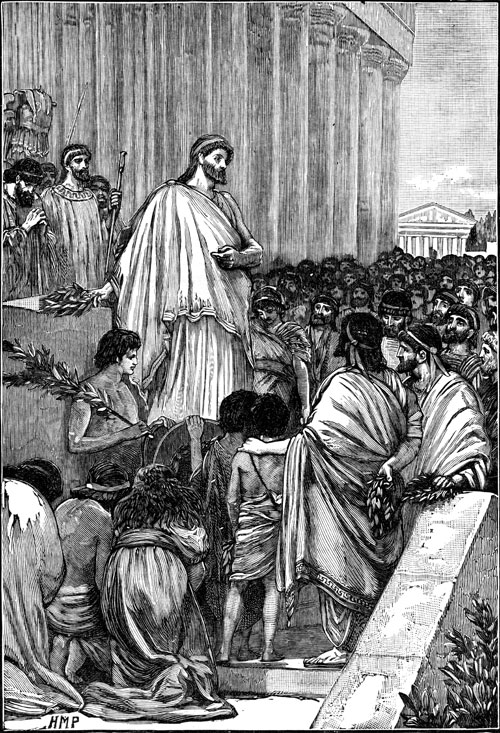 And in the fourth century, although the citizenship law of Pericles remained on the books, every variety of Levantine mongrel was claiming Athenian citizenship. The banking industry of Athens, for example, was entirely in the hands of Semites, who had taken Greek names and were awarded citizenship for “service to the state,” much in the way Jews and Negroes have been elevated to the British “nobility” by the score in recent decades.
And in the fourth century, although the citizenship law of Pericles remained on the books, every variety of Levantine mongrel was claiming Athenian citizenship. The banking industry of Athens, for example, was entirely in the hands of Semites, who had taken Greek names and were awarded citizenship for “service to the state,” much in the way Jews and Negroes have been elevated to the British “nobility” by the score in recent decades.
Darkening of Hellas
Intermarriage was rife, and the darkening of the Hellenes of Athens was well under way. Racial, moral, and cultural decline went hand in hand. The second-century historian Polybius described his countrymen as “degenerate, pleasure-seeking beggars, without loyalty or belief, and without hope for a better future.”
A century later, in the reign of Augustus, the Roman writer Manilius reckoned the Hellenes among the dark nations (coloratae genies). And so the Athenians, like the Spartiates, passed from the pages of history.
If it is difficult to believe that as great a state as Athens could pass from Nordic genius and glory to mongrelized squalor in a few centuries, just think for a moment of the racial transformation of America which has taken place in a single century. And imagine what America will be like two or three centuries hence (barring a White revolution), when Whites are a minority, outnumbered by both Blacks and Chicanos. America’s technology and industry may coast along for a century or two on the momentum acquired from earlier generations, as Athens’ culture did, but the American people—the real Americans—will have passed from the pages of history.
Excerpted from the tenth article of William Pierce’s “Who We Are: a Series of Articles on the History of the White Race”:
Greece was invaded by Greek-speaking Northerners several times during prehistory. Those who arrived in the period 2,100-1,900 B.C. founded the great Mycenaean civilization, which flourished from the end of the l6th century until about 1,200 B.C.
Homer, whose Iliad and Odyssey describe Mycenaean Greece, refers to the Greeks, or Hellenes, inclusively as “Achaeans.” In fact, however, the Achaeans were only one of the Hellenic tribes which were in Greece in Mycenaean times.
Aeolians and Ionians
In addition to the Achaeans, who occupied most of the Peloponnesus (the southern peninsula of Greece, in which Mycenae was located), there were the Aeolians and the Ionians, who occupied other portions of the mainland, many of the Aegean islands, and the west coast of Asia Minor. The Ionians, in particular, settled in Attica and were the founders of Athens.
These tribal divisions apparently predate the arrival of the first Hellenes in Greece, and it seems likely that the Achaeans, Aeolians, and Ionians invaded the Aegean region separately, over a period of several centuries.
And there were also the non-Greek Pelasgians, the Mediterranean aborigines, who occupied the lowest stratum of Greek society and substantially outnumbered the Hellenes in Mycenaean times. As pointed out in the last installment, the Mycenaean Greeks were influenced culturally by these Mediterraneans—and, as time passed, racially as well.
Divine-Born Heroes
In the late 14th and early 13th centuries B.C. more Greek-speaking Indo-Europeans arrived, coming westward across the Aegean in ships. They were Homer’s “divine born” heroes, the fathers and grandfathers of the warriors who sacked Troy about 1,250 B.C.: golden-haired Achilles, the sons of Atreus, and the other princes and kings of the Iliad. They settled in Greece, founded dynasties, and lived in a manner remarkably like that of northern Europe’s feudal lords more than 20 centuries later.
A couple of generations after the fall of Troy—exactly 80 years afterward, according to Greek tradition—a new group of divine-born warriors swept down on Greece, this time from the north. They were the Heraclidae, the supposed descendants of the blond demigod Hercules, and with them came the Dorians, the last of the major Hellenic tribes to reach the Aegean region.
Dorian Invasion
The Dorians, who had settled in central Greece a few years earlier, proceeded to conquer the Achaeans, occupy the Peloponnesus, and extinguish Mycenaean civilization. But, in so doing, they prepared the way for the rise of a new civilization which would greatly surpass the old one.
The Dorian invasion was actually a more complex phenomenon than the preceding lines might suggest. It involved repeated interactions with other peoples on a protracted journey which, although generally southward, included a number of detours, loops, and rest stops. And their legendary leaders, the Heraclidae, had already been south once before, prior to the Trojan war.
It also involved the displacement of other peoples, and it came during a period when lesser Greek-speaking tribes were undertaking invasions of their own to the south. Displaced Achaeans, Aeolians, and Ionians migrated to new areas, sometimes displacing those people already there and sometimes amalgamating with them.
Blond but Rude
The Dorians were blonder than the Achaeans they conquered, but that is only because the Achaeans had been mixing with the Mediterranean aborigines for several centuries before the Dorians arrived; originally the two tribes had been of the same racial composition.
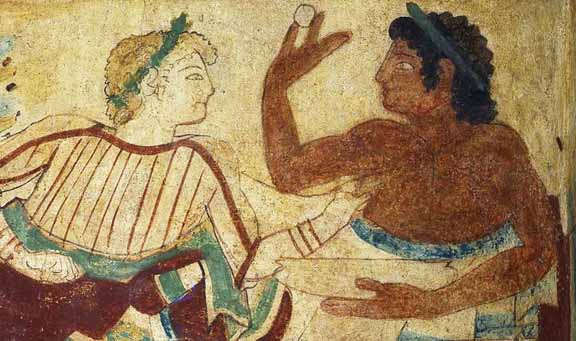 But the Achaeans were certainly more civilized than the rude, new arrivals from the north, and it was 400 years before Greece recovered from the cultural shock of the Dorian invasion. When the civilization of Classical Greece bloomed in the seventh century B.C., it comprised some elements of the old, Mycenaean culture and some which were the consequence of the social, political, and demographic changes wrought by the newcomers.
But the Achaeans were certainly more civilized than the rude, new arrivals from the north, and it was 400 years before Greece recovered from the cultural shock of the Dorian invasion. When the civilization of Classical Greece bloomed in the seventh century B.C., it comprised some elements of the old, Mycenaean culture and some which were the consequence of the social, political, and demographic changes wrought by the newcomers.
Dark Age
The four centuries between the Dorian invasion and the flowering of the literate Classical civilization are referred to by most historians as “the Dark Age,” for much the same reasons that the period between the fall of Rome, more than 15 centuries later, and the flowering of Mediaeval civilization is also called “the Dark Ages.”
In both cases a people of an older civilization, who had begun to succumb to racial mixing and decadence, was overwhelmed by a more vigorous and racially healthier but culturally less advanced people from the north. And in both cases a period of gestation took place over a dozen generations or so, during which a synthesis of old and new elements, racial and cultural, occurred, before a new and different civilization arose from the ruins of the old.
Historians’ Bias
Unfortunately, most historians tacitly assume that the records of political and cultural activity which have come down to us from periods of civilized literacy provide all the data needed to yield an understanding of the historical process. The state of development and degree of organization and complexity of city life are taken as a yardstick by which to evaluate the significance or historical importance of a particular period. And if one’s standards of value are geared to such things as the volume of commerce, the gross national product, or even the intensity of scientific, literary, and artistic activity, such a yardstick may seem, at first glance, to be proper.
Racial Values
But there are other standards of value, such as those of the National Alliance, which differ somewhat from the customary ones. For it is not in the external forms of organization and activity of a people that we see the most important criteria for making a judgment as to the significance of a particular period, but rather in the actual racial constitution of a people and in the dynamic processes which, for better or worse, are influencing that racial constitution.
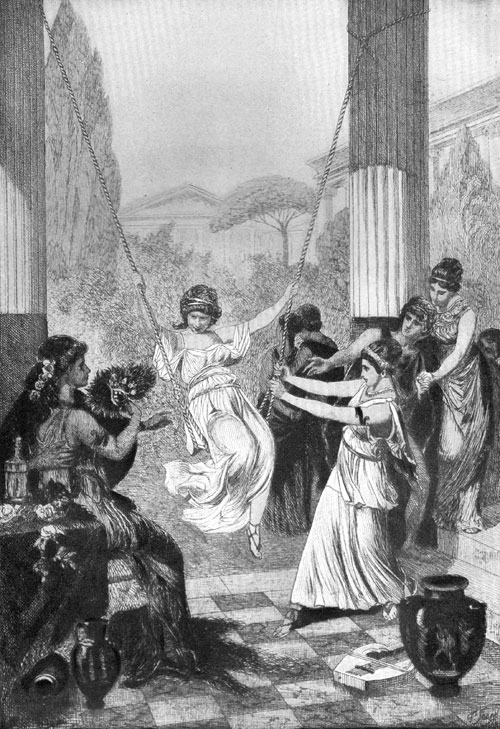 Although the basic racial constitution of a people is always intimately related to that people’s achievements in commerce, science, industry, art, politics, and warfare, still the two sets of criteria can lead to fundamentally different evaluations of a given historical period.
Although the basic racial constitution of a people is always intimately related to that people’s achievements in commerce, science, industry, art, politics, and warfare, still the two sets of criteria can lead to fundamentally different evaluations of a given historical period.
This is a consequence of the fact that race building and decay are usually strongly out of phase with civilization building and decay.
Rise and Fall of Races
Thus, the long ages between the periods of maximum civil activity—ages which the historian customarily ignores as being of only slight importance—may very well be periods of the greatest interest from a standpoint of racial dynamics.
It is, of course, true that the periods of maximum civil activity are precisely those which yield a maximum of written records, artifacts, and the other raw materials from which the historian builds his tale. But relative abundance of evidence should not be interpreted as equivalent to relative historical significance, regardless of the historian’s value criteria.
The record of the rise and fall of pure races constitutes the primary history of mankind, and the rise and fall of civilizations occupy a place of secondary importance. This statement may seem self-evident to those already accustomed to looking at history from a racial viewpoint, but it is by no means generally accepted by historians today. Until it is, much historical writing will continue to be flawed in a fundamental way.
Excerpted from the ninth article of William Pierce’s “Who We Are: a Series of Articles on the History of the White Race”:

From the far north they came, the xanthoi, the golden-haired ones: tall, blue-eyed and grey-eyed giants, on horseback and on foot, carrying their battleaxes and their spears, bringing their women and their wagons and their cattle. Warrior-farmers, craftsmen and traders, they worshipped the shining Sky Father and spoke an Indo-European language. They were the Greeks.
The Greeks—or Hellenes, as they later called themselves—crashed down upon the Mediterranean world in a long sequence of waves. The first wave, a relatively weak one—and more properly described merely as Indo-European rather than as specifically Greek—hit about 5,100 years ago, and it apparently took a roundabout course, passing first from the north into western Asia Minor, and thence, by way of the Cyclades and other islands of the southern Aegean, westward into Crete and Greece.
♣
The Minoan civilization was in its essence, however, much more a Mediterranean than a Nordic civilization. The Greeks did not bring civilization to Crete; they brought only the tendency toward civilization and the capacity for building it inherent in the higher human type which they represented.
But inevitably racial mixing occurred, sometimes soon and sometimes later. The Nordics would disappear into the mass, and the civilization they had created would lose its vital spark, stagnating and eventually retrogressing, although it might coast for centuries on its momentum after the disappearance of the Nordic element before retrogression set in. (Racemixing and retrogression were avoided only when the Nordics exterminated the non-Nordic natives of an area instead of merely conquering them. But then there was left no large serf-class for the maintenance of a culturally innovative aristocracy.)
♣
Because the Mediterraneans were only conquered and not exterminated; because they formed the bulk of the economic base on which Greek society rested; because the lifestyle of Hellenes themselves changed, becoming more dependent on agriculture than before; and because race mixture inevitably followed conquest, it is not surprising that the religion of the conquerors underwent a change and assimilated many elements from the religion of the conquered natives.
A recent discussion in another thread moves me to reproduce the following quotation of Will Durant’s The Story of Philosophy. Although Durant was almost the opposite of a racialist historian, what he says at the beginning of the chapter “From Aristotle to the Renaissance” is germane to understand why the policies that Alexander promoted were poisonous for the still adolescent Greek psyche:
Sparta blockaded and defeated Athens towards the close of the fifth century b. c, political supremacy passed from the mother of Greek philosophy and art, and the vigor and independence of the Athenian mind decayed.
When, in 399 b. c, Socrates was put to death, the soul of Athens died with him, lingering only in his proud pupil, Plato. And when Philip of Macedon defeated the Athenians at Chaeronea in 338 b. c, and Alexander burned the great city of Thebes to the ground three years later, even the ostentatious sparing of Pindar’s home could not cover up the fact that Athenian independence, in government and in thought, was irrevocably destroyed.
The domination of Greek philosophy by the Macedonian Aristotle mirrored the political subjection of Greece by the virile and younger peoples of the north. The death of Alexander (323 b. c.) quickened this process of decay. The boy-emperor, barbarian though he remained after all of Aristotle’s tutoring, had yet learned to revere the rich culture of Greece, and had dreamed of spreading that culture through the Orient in the wake of his victorious armies. The development of Greek commerce, and the multiplication of Greek trading posts throughout Asia Minor, had provided an economic basis for the unification of this region as part of an Hellenic empire; and Alexander hoped that from these busy stations Greek thought, as well as Greek goods, would radiate and conquer.
But he had underrated the inertia and resistance of the Oriental mind, and the mass and depth of Oriental culture. It was only a youthful fancy, after all, to suppose that so immature and unstable a civilization as that of Greece could be imposed upon a civilization immeasurably more widespread, and rooted in the most venerable traditions.
The quantity of Asia proved too much for the quality of Greece. Alexander himself, in the hour of his triumph, was conquered by the soul of the East; he married (among several ladies) the daughter of Darius; he adopted the Persian diadem and robe of state; he introduced into Europe the Oriental notion of the divine right of kings; and at last he astonished a sceptic Greece by announcing, in magnificent Eastern style, that he was a god. Greece laughed; and Alexander drank himself to death.
This subtle infusion of an Asiatic soul into the wearied body of the master Greek was followed rapidly by the pouring of Oriental cults and faiths into Greece along those very lines of communication which the young conqueror had opened up; the broken dykes let in the ocean of Eastern thought upon the lowlands of the still adolescent European mind. The mystic and superstitious faiths which had taken root among the poorer people of Hellas were reinforced and spread about; and the Oriental spirit of apathy and resignation found a ready soil in decadent and despondent Greece.
The introduction of the Stoic philosophy into Athens by the Phoenician merchant Zeno (about 310 b. c.) was but one of a multitude of Oriental infiltrations. Both Stoicism and Epicureanism—the apathetic acceptance of defeat, and the effort to forget defeat in the arms of pleasure—were theories as to how one might yet be happy though subjugated or enslaved; precisely as the pessimistic Oriental stoicism of Schopenhauer and the despondent epicureanism of Renan were in the nineteenth century the symbols of a shattered Revolution and a broken France. Not that these natural antitheses of ethical theory were quite new to Greece. One finds them in the gloomy Heraclitus and the “laughing philosopher” Democritus; and one sees the pupils of Socrates dividing into Cynics and Cyrenaics under the lead of Antisthenes and Aristippus, and extolling, the one school apathy, the other happiness.
Yet these were even then almost exotic modes of thought: imperial Athens did not take to them. But when Greece had seen Chaeronea in blood and Thebes in ashes, it listened to Diogenes; and when the glory had departed from Athens she was ripe for Zeno and Epicurus.
Zeno built his philosophy of apatheia on a determinism which a later Stoic, Chrysippus, found it hard to distinguish from Oriental fatalism. As Schopenhauer deemed it useless for the individual will to fight the universal will, so the Stoic argued that philosophic indifference was the only reasonable attitude to a life in which the struggle for existence is so unfairly doomed to inevitable defeat. If victory is quite impossible it should be scorned. The secret of peace is not to make our achievements equal to our desires, but to lower our desires to the level of our achievements. “If what you have seems insufficient to you,” said the Roman Stoic Seneca (d. 65 a. d.), “then, though you possess the world, you will yet be miserable.” Such a principle cried out to heaven for its opposite, and Epicurus, though himself as Stoic in life as Zeno, supplied it. Epicurus, says Fenelon, “bought a fair garden, which he tilled himself. There it was he set up his school, and there he lived a gentle and agreeable life with his disciples, whom he taught as he walked and worked. He was gentle and affable to all men. He held there was nothing nobler than to apply one’s self to philosophy.” His starting point of conviction that apathy is impossible, and that pleasure—though not necessarily sensual pleasure—is the only conceivable, and quite legitimate, end of life and action.
Epicurus, then, is no epicurean; he exalts the joys of intellect rather than those of sense; he warns against pleasures that excite and disturb the soul which they should rather quiet and appease. In the end he proposes to seek not pleasure in its usual sense, but ataraxia—tranquillity, equanimity, repose of mind; all of which trembles on the verge of Zeno’s “apathy.”
The Romans, coming to despoil Hellas in 146 b. c, found these rival schools dividing the philosophic field; and having neither leisure nor subtlety for speculation themselves, brought back these philosophies with their other spoils to Rome. Great organizers, as much as inevitable slaves, tend to stoic moods: it is difficult to be either master or servant if one is sensitive. So such philosophy as Rome had was mostly of Zeno’s school, whether in Marcus Aurelius the emperor or in Epictetus the slave; and even Lucretius talked epicureanism stoically (like Heine’s Englishman taking his pleasures sadly), and concluded his stern gospel of pleasure by committing suicide. His noble epic “On the Nature of Things,” follows Epicurus in damning pleasure with faint praise.
Nations, too, like individuals, slowly grow and surely die. In the face of warfare and inevitable death, there is no wisdom but in ataraxia, —“to look on all things with a mind at peace.” Here, clearly, the old pagan joy of life is gone, and an almost exotic spirit touches a broken lyre.
Imagine the exhilarating optimism of explicit Stoics like Aurelius or Epictetus. Nothing in all literature is so depressing as the Dissertations of the Slave, unless it be the Meditations of the emperor. “Seek not to have things happen as you choose them, but rather choose that they should happen as they do; and you shall live prosperously.” No doubt one can in this manner dictate the future, and play royal highness to the universe.
Story has it that Epictetus’ master, who treated him with consistent cruelty, one day took to twisting Epictetus’ leg to pass the time away. “If you go on,” said Epictetus calmly, “you will break my leg.” The master went on, and the leg was broken. “Did I not tell you,” Epictetus observed mildly, “that you would break my leg?” Yet there is a certain mystic nobility in this philosophy, as in the quiet courage of some Dostoievskian pacifist. “Never in any case say, I have lost such a thing; but, I have returned it. Is thy child dead?—it is returned. Is thy wife dead?—she is returned. Art thou deprived of thy estate?— is not this also returned?”
In such passages we feel the proximity of Christianity and its dauntless martyrs. In Epictetus the Greco-Roman soul has lost its paganism, and is ready for a new faith. His book had the distinction of being adopted as a religious manual by the early Christian Church. From these Dissertations and Aurelius’ Meditations there is but a step to The Imitation of Christ.
Meanwhile the historical background was melting into newer scenes. There is a remarkable passage in Lucretius which describes the decay of agriculture in the Roman state, and attributes it to the exhaustion of the soil. Whatever the cause, the wealth of Rome passed into poverty, the organization into disintegration, the power and pride into decadence and apathy. Cities faded back into the undistinguished hinterland; the roads fell into disrepair and no longer hummed with trade; the small families of the educated Romans were outbred by the vigorous and untutored German stocks that crept, year after year, across the frontier; pagan culture yielded to Oriental cults; and almost imperceptibly the Empire passed into the Papacy.
Excerpted from the fifth article of William Pierce’s “Who We Are: a Series of Articles on the History of the White Race”:
There was never total isolation between the Upper Paleolithic people and the Mediterraneans. In North Africa and in the Middle East there are a few Ice Age fossils of the taller, more rugged Upper Paleolithic types as well as of the smaller Mediterraneans. And later, during the Mesolithic and Neolithic periods, groups of men from northern Europe evidently wandered as far south as Libya, because Egyptian artists (who were of the Mediterranean type) portrayed Libyans as blond, with Nordic features. Today, of course, these Libyan Nordics have disappeared without a trace into a dark sea of Mediterraneans and Mediterranean-Negro hybrids.
Mediterraneans, however, have predominated heavily in north Africa and the Middle East for at least the last 10,000 years. In the Middle East it was they who first turned from food gathering to food producing, thus introducing the Neolithic revolution. To be sure, other subracial types made their presence felt in the south during Neolithic times—the Sumerians, for example, differed in several subracial characteristics from their Mediterranean neighbors, and several members of the Egyptian royalty were blond, the first known instance being Queen Hetep-Heres II of the IVth Dynasty, daughter of Cheops, builder of the great pyramid—but it was much more the Mediterraneans who made their presence felt in the north.
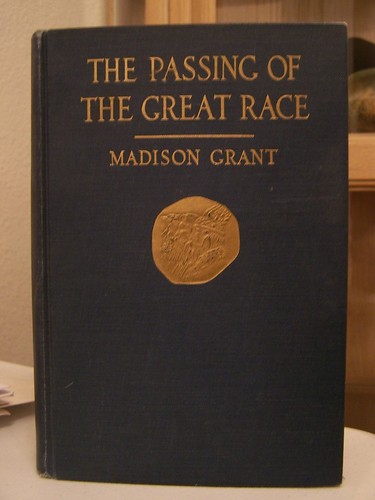
Madison Grant’s The Passing of the Great Race, published in 1916, is a classic in race studies. Below, a few excerpts from the chapter, “The European Races in Colonies” (no ellipsis added):
For reasons already set forth there are few communities outside of Europe of pure European blood. The racial destiny of Mexico and of the islands and coasts of the Spanish Main is clear. The white man is being rapidly bred out by Negroes on the islands and by Indians on the mainland. It is quite evident that the West Indies, the coast region of our Gulf States, perhaps, also the black belt of the lower Mississippi Valley must be abandoned to Negroes. This transformation is already complete in Haiti and is going rapidly forward in Cuba and Jamaica. Mexico and the northern part of South America must also be given over to native Indians with an ever thinning veneer of white culture of the “Latin” type.
In Venezuela the pure whites number about one per cent of the whole population, the balance being Indians and various crosses between Indians, Negroes and whites. In Jamaica the whites number not more than two per cent, while the remainder are Negroes or mulattoes.
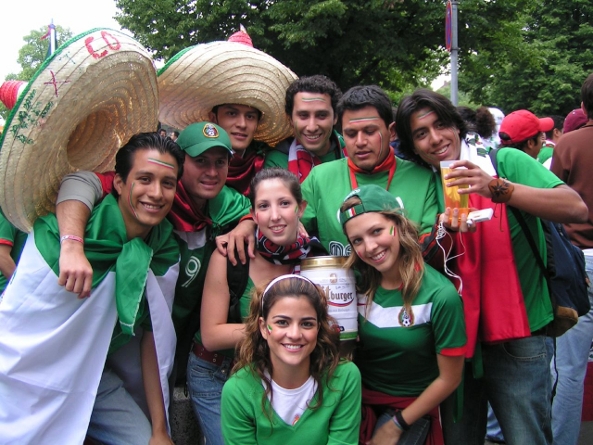 In Mexico the proportion is larger, but the unmixed whites number less than twenty per cent of the whole, the others being Indians pure or mixed. These latter are the “greasers” of the American frontiersman.
In Mexico the proportion is larger, but the unmixed whites number less than twenty per cent of the whole, the others being Indians pure or mixed. These latter are the “greasers” of the American frontiersman.
Where two distinct species are located side by side history and biology teach that but one of two things can happen; either one race drives the other out, as the Americans exterminated the Indians and as the Negroes are now replacing the whites in various parts of the South; or else they amalgamate and form a population of race bastards in which the lower type ultimately preponderates. This is a disagreeable alternative with which to confront sentimentalists but nature is only concerned with results and neither makes nor takes excuses. The chief failing of the day with some of our well-meaning philanthropists is their absolute refusal to face inevitable facts, if such facts appear cruel.
In the Argentine white blood of the various European races is pouring in so rapidly that a community preponderantly white, but of the Mediterranean race, may develop, but the type is suspiciously swarthy.
In Brazil, Negro blood together with that of the native inhabitants is rapidly overwhelming the white Europeans, although in the southern provinces German immigration has played an important role and the influx of Italians has also been considerable.
Throughout history it is only the race of the leaders that has counted and the most vigorous have been in control and will remain in mastery in one form or another until such time as democracy and its illegitimate offspring, socialism, definitely establish cacocracy and the rule of the worst and put an end to progress. The salvation of humanity will then lie in the chance survival of some sane barbarians who may retain the basic truth that inequality and not equality the law of nature.
Australia and New Zealand, where the natives have been virtually exterminated by the whites, are developing into communities of pure Nordic blood and will for that reason play a large part in the future history of the Pacific. The bitter opposition of the Australians and Californians to the admission of Chinese coolies and Japanese farmers is due primarily to a blind but absolutely justified determination to keep those lands as white man’s countries.
In Africa, south of the Sahara, the density of the native population will prevent the establishment of any purely white communities, except at the southern extremity of the continent and possibly on portions of the plateaux of eastern Africa. The stoppage of famines and wars and the abolition of the slave trade, while dictated by the noblest impulses of humanity, are suicidal to the white man. Upon the removal of these natural checks Negroes multiply so rapidly that there will not be standing room on the continent for white men, unless, perchance, the lethal sleeping sickness, which attacks the natives far more frequently than the whites, should run its course unchecked.
The Negroes of the United States while stationary, were not a serious drag on civilization until in the last century they were given the rights of citizenship and were incorporated in the body politic. These Negroes brought with them no language or religion or customs of their own which persisted but adopted all these elements of environment from the dominant race, taking the names of their masters just as to-day the German and Polish Jews are assuming American names.
Looking at any group of Negroes in America, especially in the North, it is easy to see that while they are all essentially Negroes, whether coal-black, brown or yellow, a great many of them have varying amounts of Nordic blood in them, which has in some respects modified their physical structure without transforming them in any way into white men. This miscegenation was, of course, a frightful disgrace to the dominant race but its effect on the Nordics has been negligible, for the simple reason that it was confined to white men crossing with Negro women and did not involve the reverse process, which would, of course, have resulted in the infusion of Negro blood into the American stock.
The United States of America must be regarded racially as a European colony and owing to current ignorance of the physical bases of race, one often hears the statement made that native Americans of Colonial ancestry are of mixed ethnic origin.
This not true. The Nordic blood was kept pure in the Colonies because at that time among Protestant peoples there was a strong race feeling, as a result of which half-breeds between the white man and any native type were regarded as natives and not as white men.
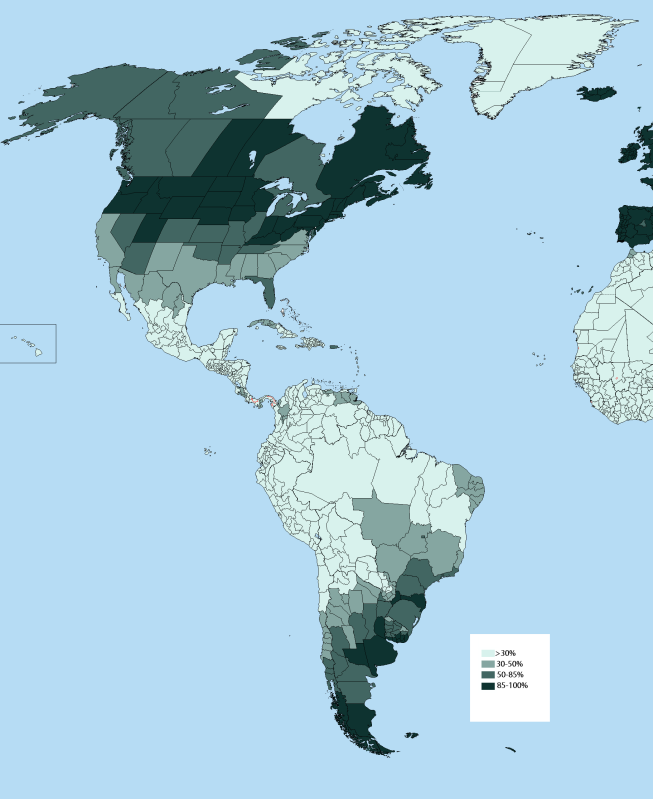 Concentration of whites in the American Continent
Concentration of whites in the American Continent
In the Catholic colonies, however, of New France and New Spain, if the half-breed were a good Catholic he was regarded as a Frenchman or a Spaniard, as the case might be. This fact alone gives the clew to many of our Colonial wars where the Indians, other than the Iroquois, were persuaded to join the French against the Americans by half-breeds who considered themselves Frenchmen. The Church of Rome has everywhere used its influence to break down racial distinctions. It disregards origins and only requires obedience to the mandates of the universal church. In that lies the secret of the opposition of Rome to all national movements. It maintains the imperial as contrasted with the nationalistic ideal and in that respect its inheritance is direct from the Empire.
Race consciousness in the Colonies and in the United States, down to and including the Mexican War, seems to have been very strongly developed among native Americans and it still remains in full vigor to-day in the South, where the presence of a large Negro population forces this question upon the daily attention of the whites.
In New England, however, whether through the decline of Calvinism or the growth of altruism, there appeared early in the last century a wave of sentimentalism, which at that time took up the cause of the Negro and in so doing apparently destroyed, to a large extent, pride and consciousness of race in the North. The agitation over slavery was inimical to the Nordic race, because it thrust aside all national opposition to the intrusion of hordes of immigrants of inferior racial value and prevented the fixing of a definite American type.
There has been little or no Indian blood taken into the veins of the native American, except in States like Oklahoma and in some isolated families scattered here and there in the Northwest. This particular mixture will play no very important role in future combinations of race on this continent, except in the north of Canada.
The native Americans [i.e., whites] are splendid raw material, but have as yet only an imperfectly developed national consciousness. They lack the instinct of self-preservation in a racial sense. Unless such an instinct develops their race will perish, as do all organisms which disregard this primary law of nature. Nature had granted to the Americans of a century ago the greatest opportunity in recorded history to produce in the isolation of a continent a powerful and racially homogeneous people and had provided for the experiment a pure race of one of the most gifted and vigorous stocks on earth, a stock free from the diseases, physical and moral, which have again and again sapped the vigor of the older lands. Our grandfathers threw away this opportunity in the blissful ignorance of national childhood and inexperience.
The result of unlimited immigration is showing plainly in the rapid decline in the birth rate of native Americans because the poorer classes of Colonial stock, where they still exist, will not bring children into the world to compete in the labor market with the Slovak, the Italian, the Syrian and the Jew. The native American is too proud to mix socially with them and is gradually withdrawing from the scene, abandoning to these aliens the land which he conquered and developed. The man of the old stock is being crowded out of many country districts by these foreigners just as he is to-day being literally driven off the streets of New York City by the swarms of Polish Jews. These immigrants adopt the language of the native American, they wear his clothes, they steal his name and they are beginning to take his women, but they seldom adopt his religion or understand his ideals and while he is being elbowed out of his own home the American looks calmly abroad and urges on others the suicidal ethics which are exterminating his own race.
 As to what the future mixture will be it is evident that in large sections of the country the native American will entirely disappear. He will not intermarry with inferior races and he cannot compete in the sweat-shop and in the street trench with the newcomers. Large cities from the days of Rome, Alexandria, and Byzantium have always been gathering points of diverse races, but New York is becoming a cloaca gentium which will produce many amazing racial hybrids and some ethnic horrors that will be beyond the powers of future anthropologists to unravel.
As to what the future mixture will be it is evident that in large sections of the country the native American will entirely disappear. He will not intermarry with inferior races and he cannot compete in the sweat-shop and in the street trench with the newcomers. Large cities from the days of Rome, Alexandria, and Byzantium have always been gathering points of diverse races, but New York is becoming a cloaca gentium which will produce many amazing racial hybrids and some ethnic horrors that will be beyond the powers of future anthropologists to unravel.

Madison Grant’s The Passing of the Great Race, published in 1916, is a classic in race studies. Below, a few excerpts from “The Competition of Races” (no ellipsis added):
Man continuously undergoes selection through the operation of the forces of social environment. Among native Americans of the Colonial period a large family was an asset and social pressure and economic advantage counselled both early marriage and numerous children. Two hundred years of continuous political expansion and material prosperity changed these conditions and children, instead of being an asset to till the fields and guard the cattle, became an expensive liability. They now require support, education and endowment from their parents and a large family is regarded by some as a serious handicap in the social struggle.
These conditions do not obtain at first among immigrants, and large families among the newly arrived population are still the rule, precisely as they were in Colonial America and are to-day in French Canada where backwoods conditions still prevail.
The result is that one class or type in a population expands more rapidly than another and ultimately replaces it. This process of replacement of one type by another does not mean that the race changes or is transformed into another. It is a replacement pure and simple and not a transformation.
The lowering of the birth rate among the most valuable classes, while the birth rate of the lower classes remains unaffected, is a frequent phenomenon of prosperity. Such a change becomes extremely injurious to the race if unchecked, unless nature is allowed to maintain by her own cruel devices the relative numbers of the different classes in their due proportions. To attack race suicide by encouraging indiscriminate reproduction is not only futile but is dangerous if it leads to an increase in the undesirable elements. What is needed in the community most of all is an increase in the desirable classes, which are of superior type physically, intellectually and morally and not merely an increase in the absolute numbers of the population.
The value and efficiency of a population are not numbered by what the newspapers call souls, but by the proportion of men of physical and intellectual vigor. The small Colonial population of America was, on an average and man for man, far superior to the present inhabitants, although the latter are twenty-five times more numerous. The ideal in eugenics toward which statesmanship should be directed is, of course, improvement in quality rather than quantity. This, however, is at present a counsel of perfection and we must face conditions as they are.
Where altruism, philanthropy or sentimentalism intervene with the noblest purpose and forbid nature to penalize the unfortunate victims of reckless breeding, the multiplication of inferior types is encouraged and fostered. Indiscriminate efforts to preserve babies among the lower classes often result in serious injury to the race.
Mistaken regard for what are believed to be divine laws and a sentimental belief in the sanctity of human life tend to prevent both the elimination of defective infants and the sterilization of such adults as are themselves of no value to the community. The laws of nature require the obliteration of the unfit and human life is valuable only when it is of use to the community or race.
The church assumes a serious responsibility toward the future of the race whenever it steps in and preserves a defective strain. Before eugenics were understood much could be said from a Christian and humane viewpoint in favor of indiscriminate charity for the benefit of the individual. The societies for charity, altruism or extension of rights, should have in these days, however, in their management some small modicum of brains, otherwise they may continue to do, as they have sometimes done in the past, more injury to the race than black death or smallpox.
Efforts to increase the birth rate of the genius producing classes of the community, while most desirable, encounter great difficulties. In such efforts we encounter social conditions over which we have as yet no control. It was tried two thousand years ago by Augustus and his efforts to avert race suicide and the extinction of the old Roman stock were singularly prophetic of what some far seeing men are attempting in order to preserve the race of native Americans of Colonial descent.
Under modern social conditions it would be extremely difficult in the first instance to determine which were the most desirable types, except in the most general way and even if a satisfactory selection were finally made, it would be in a democracy a virtual impossibility to limit by law the right to breed to a privileged and chosen few.
Experiments in limiting reproduction to the undesirable classes were unconsciously made in mediaeval Europe under the guidance of the church. After the fall of Rome social conditions were such that all those who loved a studious and quiet life were compelled to seek refuge from the violence of the times in monastic institutions and upon such the church imposed the obligation of celibacy and thus deprived the world of offspring from these desirable classes.
In the Middle Ages, through persecution resulting in actual death, life imprisonment and banishment, the free thinking, progressive and intellectual elements were persistently eliminated over large areas, leaving the perpetuation of the race to be carried on by the brutal, the servile and the stupid. It is now impossible to say to what extent the Roman Church by these methods has impaired the brain capacity of Europe. No better method of eliminating the genius producing strains of a nation could be devised and if such were its purpose the result was eminently satisfactory, as is demonstrated by the superstitious and unintelligent Spaniard of to-day. A similar elimination of brains and ability took place in northern Italy, in France and in the Low Countries, where hundreds of thousands of Huguenots were murdered or driven into exile.
Under existing conditions the most practical and hopeful method of race improvement is through the elimination of the least desirable elements in the nation by depriving them of the power to contribute to future generations. It is well known to stock breeders that the color of a herd of cattle can be modified by continuous destruction of worthless shades and of course this is true of other characters. Black sheep, for instance, have been practically obliterated by cutting out generation after generation all animals that show this color phase, until in carefully maintained flocks a black individual only appears as a rare sport.

